On Friday I noted that adjusting first time jobless claims by population gives you the "initial jobless claims rate," which has tracked very closely over the last half century with the unemployment rate, with very few exceptions - one of which is now.
Surprising relationships like this are powerful motivation to the data nerd in me, so over the weekend (while I wasn't going to holiday parties), I took a further look. This is the first follow up post on what I found.
The following graphs come from a terrific site called Thumbcharts. The title of the graph is "Jobless Claims lead the Unemployment Rate." The methodology is explained as follows:
This chart shows the annual rate of change for initial jobless claims and the unemployment rate. Each series is modified with a six-month moving average and is compared using standard deviation.In other words, as of now we are comparing the average of initial jobless claims from June 11 through December 11 of this year, with the same six month period last year. Similarly, the average unemployment rate from May through November of this year is being compared with the same average from last year.
Here is the resultant graph:

The graph is interactive, so it allows you to zoom in on particular periods. So I chose those where the unemployment rate did not decline as much as the change in initial jobless claims. The software also displays the actual data for one month when you place your cursor over that month, but it doesn't reproduce, so I am noting it in my comments to each graph.
But here is the summary: in every case except for the 1980-1982 "double dip," a decline of 10% as measured of initial jobless claims was followed within 10 months by a similar decline in the unemployment rate. Increase that to a 20% decline in the measure of initial jobless claims, and the period shrinks to 8 months.
Here is the 1980-1982 "double dip" recession period:

Initial Jobless claims were down 10%+ YoY by May 1981. The YoY low in the change in the unemployment rate (i.e., a percentage change in a percent) was -1.2% in September 1981.
Here is the 1991 recession and "jobless recovery" thereafter:
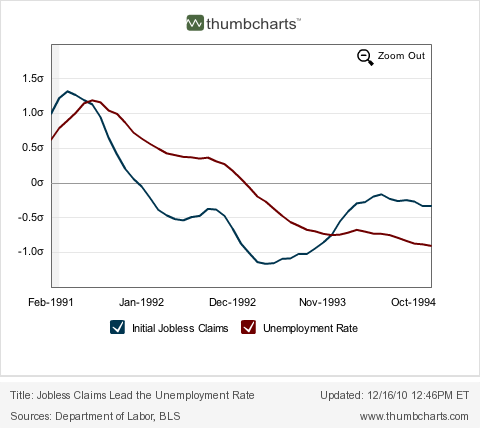
Initial Jobless claims were down 10%+ YoY by January 1993. They were down 20%+ by April 1993. The Unemployment Rate was down 10%+ in November 1993 -- 11 months later.
Here is the 2001 recession and "jobless recovery" thereafter:
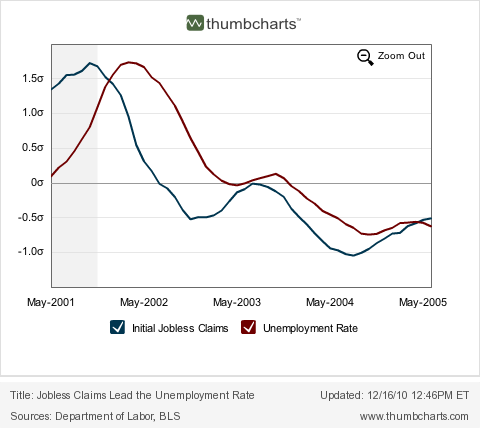
Initial Jobless claims were down 10%+ YoY by March 2004. The Unemployment Rate was down 10%+ in September 2004 -- 6 months later.
And here is the Great Recession and current recovery:
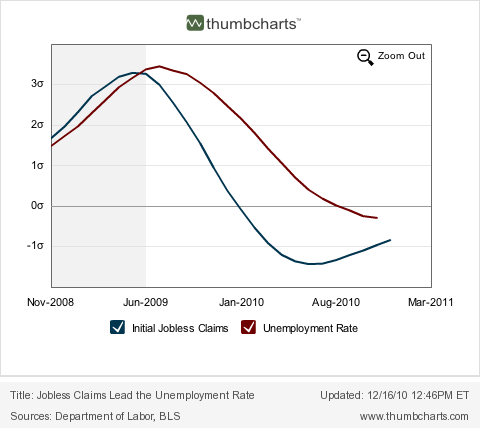
Initial Jobless claims have been down 10%+ by March 2010, and 20%+ since April. The Unemployment Rate is only down -1.5% in November 2010. As with the metric I posted Friday, presently this is by far the weakest decline in the unemployment rate compared with initial jobless claims in the entire series.
The two data series' past relationship argues that if initial jobless claims continue to drift lower to 400,000 over the next 6-8 months, by that time unemployment is likely to be under 9%. To repeat the 1980-82 scenario, there would have to be a shock (like a large further increase in the price of Oil, or another Euro crisis, or similar), sending initial claims higher, in order to negative the decline in the employment rate.
------
P.S. SilverOz asked me to look into initial claims are a percentage of the labor force. I have done so, and here is the comparison between that (green) and initial claims are a percentage of population (blue) (I multiplied this by two so it would be easier to compare):
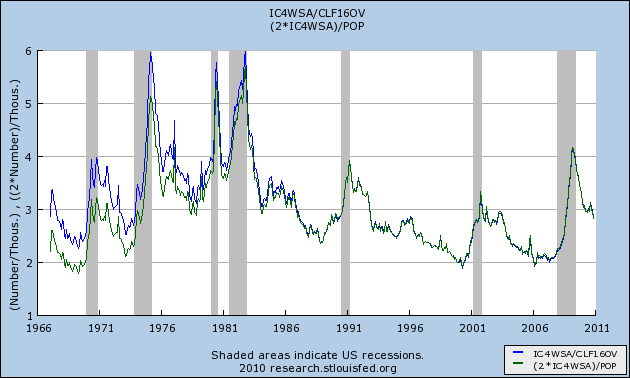
As you can see, they are virtually identical since 1980. This reflects the gradual entry of women into the workforce.
In this graph I add in the unemployment rate (red):
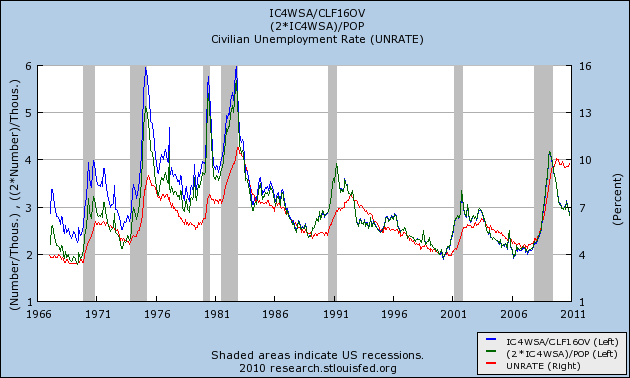
The relationship tracks more closely via my original metric.
The data series start in the 1960's, so unfortunately I cannot take the comparison back further.
I have much more to say about this, hopefully tomorrow.